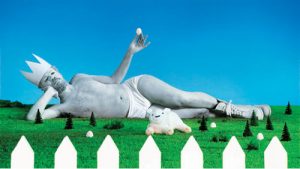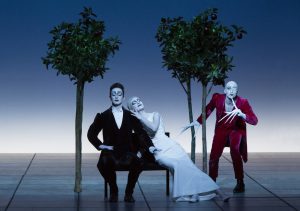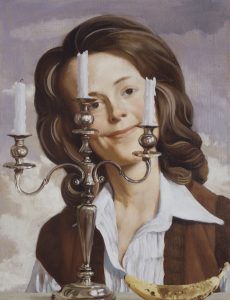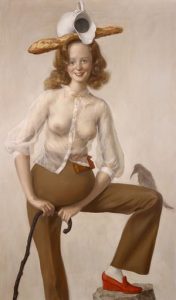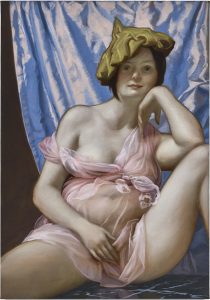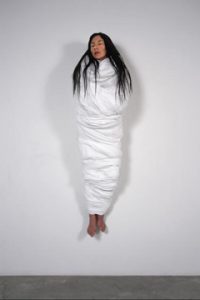Un grand nombre d’oeuvres que j’ai vues au Carnegie International font etat de la douleur endemique des temps presents. Aucunement ostentatoire cependant, cette magnifique exposition montre les oeuvres pour leur force unique, sans toutefois les assujettir a une quelconque thematique, trop souvent reductrice. Il y a une assurance et une serenite dans les choix et dans la maniere de montrer les oeuvres qui est tout au credit du conservateur de l’exposition, Richard Armstrong. Une quarantaine d’artistes ont ete invites a presenter une ou plusieurs oeuvres dont la qualite, la presence et la force d’expression sont pour la plupart remarquables. L’ensemble a le poids d’un authentique constat sur l’etat du monde. Le visiteur en ressort enrichi, sinon ebranle par les vagues d’emotion pure qui chargent l’atmosphere des salles qu’il vient de traverser. Par rapport aux recentes Documentas et Biennales de Venise, et a bien d’autres expositions de groupe qui ces dernieres annees ont pu apparaitre assommantes en cedant a la facilite, a la mode, au sensationnalisme, ou tout bonnement au vide irreflechi, cette version de la Carnegie International m’apparait etre une reussite notoire.
La premiere salle fait voir des oeuvres de Donald Judd, disparu en 1994. Une entree symbolique, placee sous le signe de la rigueur de Judd et de son inlassable quete de sculpteur a propos de l’espace, du rythme et de l’interrelation jamais resolue entre le spectateur et l’oeuvre, entre le corps et l’objet. Au mur, des tableaux de Remy Zaugg ou se superposent en palimpsete des phrases comme Perhaps you are not here yet, ou Imagine you are here, ou encore Look you are here. Du fond de la memoire, absence et presence se chevauchent comme l’invisible et le visible. D’emblee, c’est dans cet entre-deux que Judd et Zaugg signalent que commence cette exposition.

Gary Hill, quelques pas plus loin, nous ramene a des considerations moins phenomenologiques quoique le spectateur soit cette fois non seulement interpelle dans sa perception de l’objet, mais tout a fait integre. Invite a se plonger dans le noir complet, il assiste a une projection simultanee de films video sur plusieurs ecrans. Intitulee Dervish, cette oeuvre nous fait entendre la musique de derviches qui va en s’intensifiant a la suite de la diffusion de mots-sons quasi indechiffrables. Les images, qui se multiplient et se complexifient dans le temps, sont par moments difficiles a dechiffrer elles aussi. On distingue d’abord une lampe et le geste de quelqu’un qui l’allume. Puis en juxtaposition, des rayonnages de livres sur une bibliotheque juxtaposes a des mains dont les phalanges placees verticalement font etrangement reference visuellement aux livres dresses sur les tablettes. La musique du Moyen-Orient superposee aux images de livres font surgir l’interdit de savoir qui existe dans cette region du monde. Les images de mains coupees par les bords de l’ecran en signalent la vulnerabilite et la precarite. Cette piece nous fait voir les rapports entre le savoir et l’integrite humaine et comment se font echo violence spirituelle et violence corporelle.
Doris Salcedo et Guillermo Kuitca nous entrainent encore ailleurs dans cette evocation sourde de la violence. L’installation de Salcedo consiste en l’assemblage de plusieurs elements fabriques a partir de meubles glanes en Colombie ou elle habite. Ces meubles decoupes et reassembles selon une logique non plus fonctionnaliste mais tout a fait poetique, sont retravailles avec un enduit de ciment qui en recouvre les surfaces. Les pieces sont dispersees dans la salle d’exposition dans une atmosphere de semi-debarras. La dispersion, l’abandon, la destruction sont des notions qui envahissent le spectateur deambulant a travers ces sculptures epaves d’un autre lieu et d’un autre temps, une realite proche-lointaine, qui devient etonnamment presente et pregnante de sens dans cette installation. Kuitca dessine et peint de grands tableaux qui font reference a des univers semi-reels, mi-archeologiques, mi-utopistes dans leur facture. Se donnant l’allure de grands projets d’architecture, ses oeuvres nous montrent des plans de batiments monumentaux destines a accueillir beaucoup de monde. Ainsi, les ensembles sontils fragments en une serie d’unites quasi microscopiques, qu’on lit bien sur comme etant les sites reserves aux humains… de toutes petites entites dans le grand tout. Ce jeu entre l’infiniment petit et le tres grand est fascinant chez Kuitca qui laisse flotter ses diagrammes insenses dans des halos de couleurs pastel legerement souilles, comme uses par le temps, le travail, ou la memoire.
L’effet d’empreinte du reel, Rachel Whiteread nous le ressert litteralement alors qu’elle livre ici une installation composee d’elements moules sur des dessous de chaises. Les elements sont fabriques de resines translucides et colores delicatement de verts, de bleus, d’ambres et de roses. Ils sont alignes en rangees pour former un grand carre qui envahit presque toute la salle. Ces formes vaporeuses et fantomatiques evoquent des espaces insaisissables, auxquels nous n’avons et n’aurons jamais acces. Une part du monde est ainsi, la part de l’inconnaissable, la part de l’ignorance, la part du manque aussi contre laquelle se bute toute individualite. La aussi, il est question de memoire et de ce que celle-ci laisse voir et ne laisse pas voir. Il en est de meme pour l’installation de Richard Artschwager, un assemblage de sculptures mimant la forme et les materiaux de caisses de transport d’oeuvres. Celles-ci se presentent sous toutes sortes de formes, cubiques, oblongues, verticales, horizontales. Le tout, contenant on ne sait quoi, en attente d’on ne sait quelle destination. Les caisses-sculptures sont la au bord d’un destin inconnu, mimant ostensiblement des formes du reel, sans pour autant s’y livrer. Il y a chez cet artiste un refus notoire de s’abandonner a toute facilite de perception et d’interpretation, une saine resistance qui active le doute et l’interrogation. La piece de Robert Therrien, que l’on peut voir non loin de la salle Artschwager, est davantage spectaculaire. Une table et quatre chaises sont presentees a une echelle agrandie, de sorte que le spectateur circule sous la table et entre les pattes des chaises. Ce changement d’echelle declenche chez ce dernier un processus physique d’exploration inusitee double d’une anamnese, le ramenant a ses perceptions d’enfance: menace, peur, ecrasement, secret, jeu de cache-cache meme. Ces trois artistes creent chacun a leur maniere une distance avec le monde et la maniere de le percevoir, liant la perception physique et le domaine psychique dans des modes scupturaux propres a chacun. Il en est de meme pour Thomas Locher qui, moins sensoriel dans son approche, melange objets et langage, offrant une lecture inusitee de concepts linguistiques revus a travers une physicalite empruntee a des objets familiers, tableaux, chaises, tables. Il s’agit d’une approche conceptuelle qui n’est pas denuee d’interet faisant litteralement sentir la materialite et la sensibilite, l’epaisseur physique des mots, l’emotion tangible derriere.
On a l impression que les dessins que produit Marlene Dumas depuis quelques annees sont l’expression meme d’une emotion febrile et a fleur de peau. Une des series presentees au Carnegie s’intitulait Betrayal et montrait des visages (28) peints a l’encre gris. Proches de l’informe, ces visages, dont les couleurs vont du plus pale au plus fonce (explorant toutes les teintes possibles que l’on peut donner avec l’encre), questionnent l’identite, affirment la difficulte de vivre et interrogent la justice qui gouverne la vie des femmes dans le monde. Paradoxalement ici, l’identite et le caractere sont renforces par l’autre, l’une n’existant pas sans l’autre et vice-versa. Dans l’orientation des regards et des visages s’echafaude une forte tension, qui contraste avec la fragilite et la sensibilite qui emanent des portraits individuels. La communaute des races, la communaute tout court estelle une supercherie, comme le laisserait entendre le titre de l’oeuvre? Il semble que Chantal Akerman se soit aventuree dans les memes eaux avec sa superbe installation, D’Est. Dans une salle remplie de moniteurs video places a hauteur d’yeux sont diffuses des films qu’Akerman a tournes en Europe de l’Est. Des films qui montrent la vie de tous les jours, une vie ou l’ordinaire devient extraordinaire grace au statut que lui donne la camera et dont on sait qu’Akerman joue a merveille depuis ses tout premiers films. L’oeuvre est extremement choregraphique (on sait qu’Akerman a ete proche de Pina Bausch et d’Anne Teresa de Keersmaeker), en ce sens qu’elle donne au mouvement et au temps toute la place. Essentiellement, elle a filme la foule dans ces pays de l’Est (pays de l’Autre), mais c’est l’individu qu’on se met a regarder. Et dans cette installation massive, ou en tant que spectateur on n’echappe pas a la multiplicite des ecrans et a l’espace physique qu’ils occupent dans la salle, c’est d’individu a individu qu’on se trouve confronte, d’un temps reel a l’autre, dans une difference marquee par l’espace et toujours presente.
Par rapport a cette idee de refraction du temps, de decalages, il faudrait aussi signaler les oeuveres d’Angela Grauerholz, de Craigie Horsfield et de Stan Douglas. Dans leur flou distinctif et leur grisaille habituelle, les photographies de Grauerholz nous plongent dans des temps autres, des temps ou passe, present et futur se fusionnent dans une latence particuliere. Sur la photo montree au Carnegie, une femme eblouie par un eclat de lumiere leve son bras a la hauteur de ses yeux: geste de protection, de defense, imminence d’un instant potentiellement dangereux. Voila le futur dont le present est toujours menace. Voila le present en tant qu’instant du peril. C’est un peu ce qu’on voit aussi dans les photographies de Horsfield qui, montrant des univers desuets ou lointains (ou en instance de disparition comme cette tete de rhinoceros), mele passe et present par l’actualite restituee de son medium. Douglas presente une installation filmique, Der Sandmann, qui confronte l’univers d’un vieux et celebre studio de Berlin ou il a tourne et qui est appele a disparaitre avec les jardins populaires allemands, et ce sur des textes alteres de Freud et de Hofmann. Commentaire complexe sur un monde a la fois en disparition et en reconstruction.
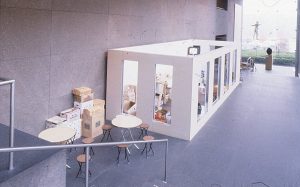
Si la plupart des oeuvres abordees jusqu’a maintenant semblaient davantage s’interesser a l’environnement actuel et a ses modes d’apprehension, plusieurs oeuvres presentes au Carnegie International abordaient de plus pres la question du corps et de l’individu. Notons celles de Robert Gober, de Cindy Sherman et de Tony Oursler. De Gober, on pouvait voir deux pieces dont Man in Drain. Un torse nu d’homme vu au fond d’un egouttoir, au milieu duquel on pouvait distinguer un drain. Gober nous a habitues a ses corps de cire perces de drains de lavabos. Il renforce ici la metaphore en placant ce torse ainsi. Le corps chez Gober est permeable et morcele, ses limites sont celles du monde physique ou il s’inscrit, il s’en degage la souffrance que l’on sait. Le choc et l’ecoeurement sont grands a voir dans la seconde piece de Gober dans cette exposition: un feu de foyer ou sont placees des jambes de petites filles au lieu de buches. Choquantes aussi sont les images photographiques de Cindy Sherman, images mi-fausses, mi-vraies, montages de visages humains et de corps de poupees, rappelant etrangement Bellmer. L’horreur et la facticite sont au rendez-vous, la poupee devenue ainsi humaine se transforme en monstre abject. Sherman reussit cependant a dedramatiser cet abject en le dramatisant justement, elle rend l’artifice tellement evident et explicite qu’elle detourne le cours meme de l’horreur. C’est le sentiment qui se degage egalement des oeuvres de Tony Oursler. Les poupees de chiffons ou organes de chair sur lesquels il projette des visages humains en diffusant des textes ou s’entendent l’abus et la douleur sont parmi les pieces les plus saisissantes de l’exposition. Avec des moyens minuscules, quelques chiffons, un minimum de technique et d’objets, il cree une atmosphere lourde de sens au plan psychique. Le spectateur se sent en intimite avec ces situations. Intolerable et liberateur a la fois. Oursler, par son sens de l’ironie, du jeu, de la mimesis, offre une prise de conscience inusitee du probleme de la douleur psychique.
Dans les grands coups marques par cette exposition, il faudrait encore mentionner la reunion de deux grands peintres, l’Americain Chuck Close et l’Allemand Sigmar Polke. De la meme generation, ils nous offrent des versions picturales distinctes et fortes. Deux histoires livrees a la face du monde et qui traitent avec brio du monde contemporain et de ses modes de representation: tous deux pop sans l’etre, loin de la dimension heroique du pop, mais proches de son analyse des parametres visuels de nos societes. Brillante idee de les reunir ici.
Cette exposition, on peut le redire apres coup, traite bien de l’etat du monde et de la douleur qui s’y mainfeste. Mais elle traite aussi de la situation de l’artiste et du role changeant qui lui incombe ou qu’il se trace, serait-il preferable de dire. Stephan Balkenhol est revenu a une maniere archaique de travailler. Il sculpte le bois. De l’informe, il cree une forme nouvelle; ce qui en resulte la plupart du temps ce sont des figures humaines, des tetes geantes, des corps de toutes tailles, hommes, femmes. Rien d’heroique non plus dans ces sculptures. Des figures anonymes, hommes et femmes de tous les jours. Ils ont la posture de statues grecques, l’aspect un peu raide, le regard un peu lointain. Ces figures naviguent dans un proche-lointain, un univers qui est le notre sans l’etre, un univers en transit a bord duquel Balkenhol nous convie. Franz West semble nous convier au voyage inverse, de la forme vers l’informe, alors qu’il s’approprie des objets quotidiens pour les transformer, a l’aide de couches de platre, en objets de derive. Il en resulte des masses qu’on dirait figees par le vent, tant leur mouvement part dans tous les sens. Ces pieces servent a creer des environnements ou le spectateur est invite a sejourner, comme a bord d’un vaisseau spatial vers l’inconnu.
Rirkrit Tiravanija nous entraine egalement dans des mondes nouveaux avec ses propositions tout a fait personnelles. Installe a demeure au musee, il y cuisine et vit a longueur de jour, invitant les spectateurs a partager cette vie avec lui, et menant autant que possible une entreprise de nature ecologique, earth-friendly et people-friendly… Cet American de souche argentine emprunte ce courant un peu delaisse ces dernieres annees de l’art et de la vie… c’est inevitable et pertinent vu le monde changeant dans lequel on est, vu les changements, devenus imperativement necessaires. Il nous semble evident a nous aussi que le musee ne peut a lui seul contrer la douleur du monde, meme si l’edition 1995 de la Carnegie International en fut un moment de reflexion privilegie. Ce monde est a reinventer et l’art est appele a y jouer un role essentiel, ebranlant les frontieres de nos modes d’apprehension comme de nos institutions.


